Contributory members are able to log private notes and comments about each site
Sites Anne T has logged. View this log as a table or view the most recent logs from everyone
Powdonnet Well (Morland)
Trip No.90 Entry No.4 Date Added: 31st Jul 2018
Site Type: Holy Well or Sacred Spring
Country: England (Cumbria)
Visited: Yes. My rating: Condition 3 Ambience 3 Access 4
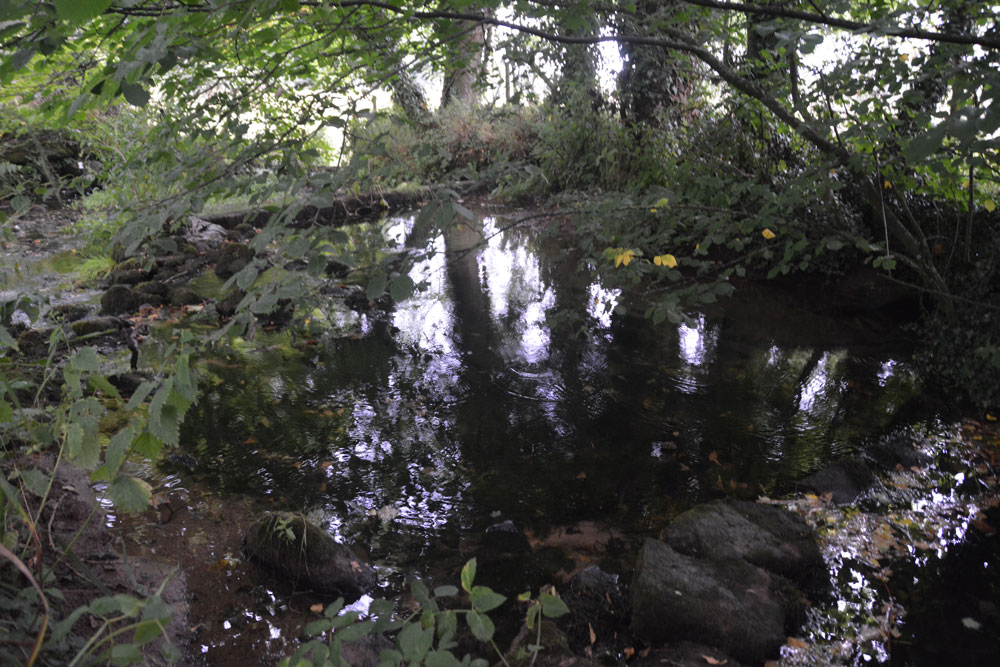
Powdonnet Well (Morland) submitted by Anne T on 31st Jul 2018. The well pool is clear and inviting. Parts of it, particularly under the tree to the right hand side of the photograph, look deep, but the stones at the bottom of the pool can be clearly seen. A little overgrown, and in the sunshine would be a lovely spot.
(View photo, vote or add a comment)
Log Text: Powdonnet Well, Morland, Cumbria: If not quite so overgrown, I'd have awarded this a '4: Good' rating on Ambience (despite the downpour after the long dry spell!). This well is marked on the OS map, but there is no mention in either Pastscape or HE.
The Holy Wells of Cumbria booklet describes this well as: “Morland. Location: Approx. 6.5 miles south east of Penrith. At the northern end of Morland village. Take road from Morland towards Cliburn. On right, as you leave village, opposite ‘Morland’ sign, is a small parking area. The standing stone and pool are close to the road.
The well had been neglected since the booklet was written in 2008 and we had to pick our way through the tangle of tree branches. We were just approaching the site of the well when the heavens opened, and there was an absolute downpour. Somewhat protected by the trees, we nevertheless decided to explore.
The easiest way to the standing stone and well is to find the overgrown footpath at the southern end of the bridge across the small stream which crosses under the road and joins the Morland Beck to the east of the well site.
The water in the pool is crystal clear. The water really does appear from nowhere. We stood at the southern end of the spring, listening to the water rushing up from the ground. The pool has been created by a couple of stone/concrete dams across the spring just to the northern part of the site. A lovely place. Next time we visit, remember to bring pruning shears!
Chapel Well (Staffield)
Trip No.90 Entry No.3 Date Added: 31st Jul 2018
Site Type: Holy Well or Sacred Spring
Country: England (Cumbria)
Visited: Yes on 30th Jul 2018. My rating: Condition 3 Ambience 5 Access 4
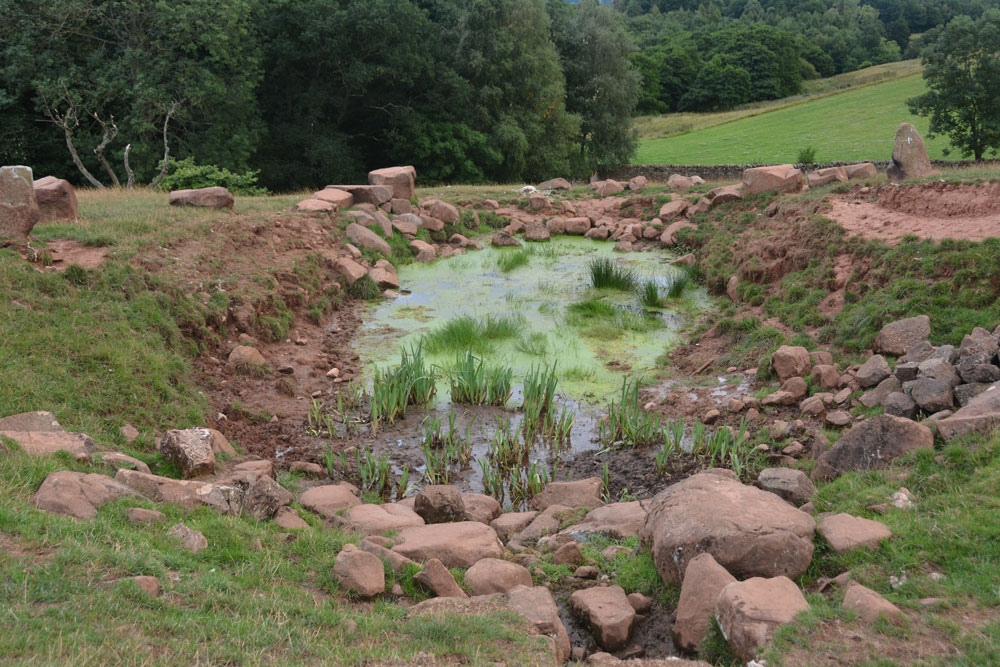
Chapel Well (Staffield) submitted by Anne T on 31st Jul 2018. The well with its pond, taken from the western end. The water bubbled out of the ground just in front of the stone bowl at the time of our visit, and was a fair flow. Between the well pool and the 'pond proper' were some lovely clumps of irises. Certainly peaceful and restful.
(View photo, vote or add a comment)
Log Text: Chapel Well, Near Staffield, Cumbria: Not far from the incised stone at Cross House. We parked near the junction down the hill where there was room to bump up onto the grass verge and walked to the gate at NY 53603 43081, which is signposted towards ‘Dale’. We kept the dry stone wall to our right hand side, and as we approached the gate into the wood, a stone drinking trough and a tree with a ditch leading from it came into view. Slightly up the slope there were some red sandstone boulders on the horizon, with a sheep track leading up to it.
The drinking trough is at NY 53774 43194 and is similar to the ones we saw at Newbeggin. The tree with its accompanying ditch is at NY 53778 43244, and there are signs of another stone structure under the tree, now dry and ruined, but possibly a secondary outlet for the well during wet weather. At the bottom of the slope, a small hole leads through the stone wall into Croglin Water just beyond.
This well is certainly in a lovely spot, hidden in a dip towards the top of the slope. There were two ‘standing stones’, one on either side of the large well pool; the rest of the large boulders had been quarried and placed around the top of the pool. A circular well bowl can be seen at the top, centre of the well, and a good flow of water came from the well (not as much as Powdonnet Well). Half a sheep had been left to rot at the south eastern end of the pool, which spoilt the ambience, and stopped me from exploring the exit pipe, but taking that away, we could have lingered for a long while. Beautiful!
Cross House Incised Stone
Trip No.90 Entry No.2 Date Added: 31st Jul 2018
Site Type: Ancient Cross
Country: England (Cumbria)
Visited: Yes on 30th Jul 2018. My rating: Condition 3 Ambience 4 Access 4
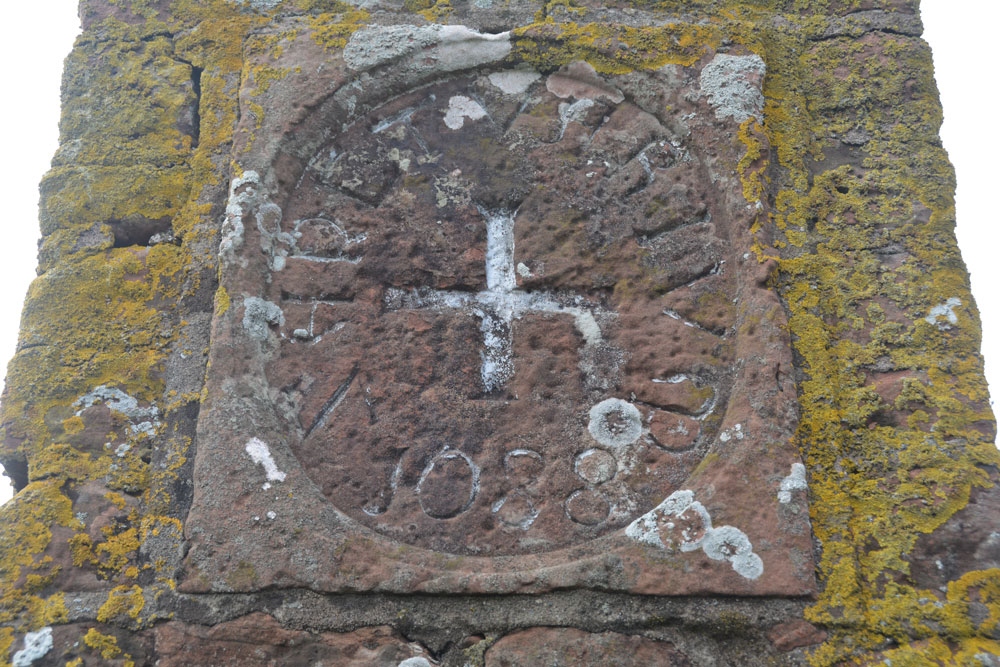
Cross House Incised Stone submitted by Anne T on 31st Jul 2018. The inscribed stone, now mounted in a 19th century pillar. The age of the stone is unknown, but it is believed to be the remains of an old wayside or boundary cross.
(View photo, vote or add a comment)
Log Text: Cross House Incised Stone, Staffield: We parked at NY 53519 43219, where a gate lets you into the footpath which goes down the hill, and joins a second footpath to Chapel Well. We walked back up the hill towards Cross House. The pillar was just visible through the hedge. We let ourselves in to the field by the gate near Cross House (there was no-one around to ask) and quickly walked to the pillar to photograph the cross.
Interesting that HE classes this as a sanctuary cross, and Pastscape as a possible wayside or boundary cross.
On processing the photographs to post to the Portal this morning, I realised we’d been to this site in October 2015, but hadn’t submitted a new site or photos to the Portal. I had asked the lady hanging out her washing in the garden of Cross House and she’d given us permission to go into the field.
Splendid views south over to the River Eden and the site of the old priory. The pillar was very near the hedge, , but it was still possible to get photos of the recut stone in its 19th century pillar.
St Mary's Well (Wreay)
Trip No.90 Entry No.1 Date Added: 31st Jul 2018
Site Type: Holy Well or Sacred Spring
Country: England (Cumbria)
Visited: Yes on 30th Jul 2018. My rating: Condition 3 Ambience 4 Access 4
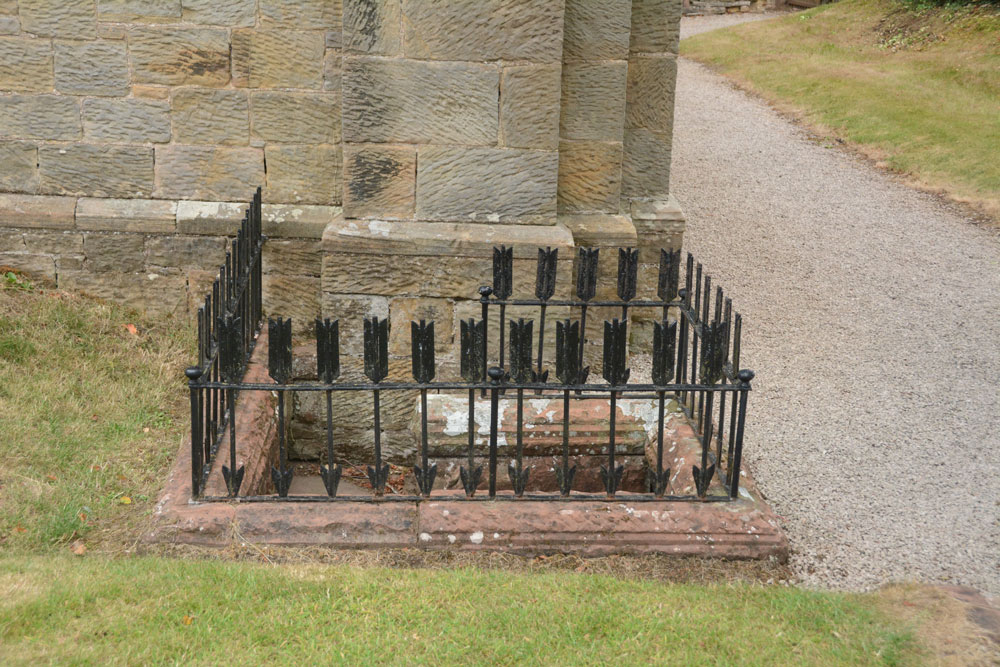
St Mary's Well (Wreay) submitted by Anne T on 31st Jul 2018. Approaching the well, with its curious railings made up of arrows, which represent 'death' according to the leaflets in the church.
(View photo, vote or add a comment)
Log Text: St Mary's Well and copy of the Bewcastle Cross, Wreay: This is a delightful little village, with some very old houses. The church is very easy to find, right in the middle of the village, opposite the colourful school, with plenty of parking on the streets nearby.
This well is to the southern side of the exterior western wall, although it has been dry for some considerable time. The well spout, in the form of an animal head, is quite superb and unusual (like the gargoyles on the roof line of the church).
The Holy Wells of Cumbria booklet (page 14) describes this well as:
Location: Approx. 9 miles south of Carlisle. The well is found by the front wall of St. Mary’s Church, Wreay.
Description: Although it is unknown whether this was a holy well, the highly unusual and attractive church is well worth a visit in itself. The original church dates back to 1319, and was rebuilt by Sarah Losh in 1840-42 – see also well 4 at Brisco – in memory of her sister Catherine and her parents. Italian in style, it is full of highly original and deeply symbolic carvings in wood and stone, many representing in forms from nature the eternal contrast between light and dark, or life and death. The well outside is a curious construction surrounded by cast iron arrows. Dog-leg stone steps lead down into the well, where water flows from a lion’s (or dog’s head) into a aquare stone piscina blessed with a solitary green fern and scattering of copper coins. The well (in 2008) was recently restored and is in excellent condition."
There was no water, no fern and no coins when we visited. Whilst the church, the sundial and the font in the churchyard are all scheduled, there is no mention of the well or the copy of the Bewcastle Cross. The church is indeed well worth looking inside. Andrew opened the door and said "I'm leaving you to go in first - it's scary!"
Clenamacrie Stone Row
Trip No.87 Entry No.9 Date Added: 31st Jul 2018
Site Type: Stone Row / Alignment
Country: Scotland (Argyll)
Visited: Yes on 17th Jul 2018. My rating: Condition 3 Ambience 3 Access 5
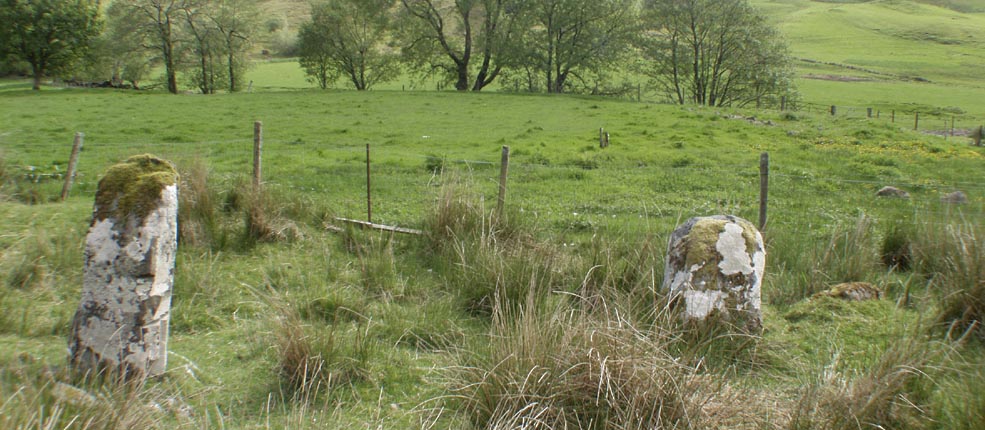
Clenamacrie Stone Row submitted by Tom_Bullock on 26th Feb 2005. Photo used by kind permission of Tom Bullock. More details of this location are to be found on his Stone Circles and Rows CD-ROM.
(View photo, vote or add a comment)
Log Text: Glenamacrie/Clenamacrie Stone Row: After An Dun, we headed off a few hundreds yards west back down the road. I took two lots of photos here, because I think I mistook an outcrop (an unmown area of the field with stones protruding, at NM 92745 28409). Andrew had mentioned both a ‘stone row’ and ‘four stones forming a chamber’, so I thought I had photographed the right thing. Driving down to the farm, I spotted the right three standing stones in a field nearer the farm, which I also photographed. Andrew said the ‘lump’ in the field behind was also a cairn, but this was the closest I could get, so we’ve got these standing stones with the cairn behind.
I wish now I’d had the courage to go and ask to see these up close, but I felt intimidated because the farm was so big and the gate into the field seemed to be along the far end of the track. I can’t get used to the ‘responsible right to roam’ act in Scotland, but it still feels like trespassing at times, especially when you are going doing someone’s driveway.
Glenamacrie Dun
Trip No.87 Entry No.8 Date Added: 30th Jul 2018
Site Type: Stone Fort or Dun
Country: Scotland (Argyll)
Visited: Yes on 17th Jul 2018. My rating: Condition 3 Ambience 4 Access 4
Glenamacrie Dun submitted by caradoc68 on 6th Feb 2012. Probably one of the easiest Dun's you will ever drive too, get out of car and you are standing on An Dun.
(View photo, vote or add a comment)
Log Text: An Dun/Glenamachrie Dun: Not far to the east of the cairns and standing stone at Glenamachrie Farm. We bypassed those, and came here first to take photos then turn the car around to go back and photograph the standing stones and cairn. When husband came back, he said he’d had the most bizarre experience. As we stopped at the different sites along this road, we kept being passed by three men in a white truck; Andrew said they’d stopped him asking him if he’d seen a crane. I think on these narrow roads we’d most definitely have been run off the road and noticed. He said ‘no’. However, that alerted us to having to move on, just in case.
Left alone in the middle of nowhere for a few minutes, my first reaction was: “If this is a fort, there weren’t really any outer banks and ditches – this just looked like a large outcrop with a small terrace around it.” These Scottish duns/fort are quite unlike the hillforts we have in England. But then I hadn’t seen Dun Add.
Glenamachrie Cairn
Trip No.87 Entry No.7 Date Added: 30th Jul 2018
Site Type: Cairn
Country: Scotland (Argyll)
Visited: Yes on 17th Jul 2018. My rating: Condition 3 Ambience 3 Access 5
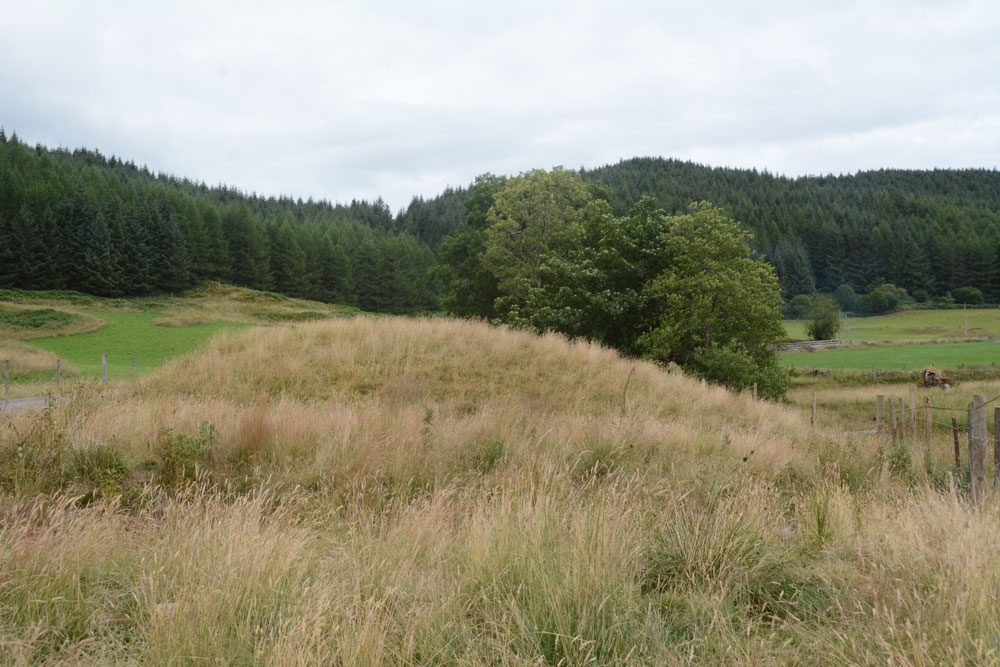
Glenamachrie Cairn submitted by Anne T on 29th Jul 2018. The Glenamachrie Cairn from the south west. Canmore tells us it is oval and measures 18.6 by 17.4 metres, standing to a height of 1.9 metres.
(View photo, vote or add a comment)
Log Text: Glenamachrie Cairn: This cairn was marked on the map on the way to An Dun fort and the standing stone to the east; I asked “if we spot this, can we stop”, and there it stood, almost on top of the road. As the road was quite busy with lots of cars and trucks going by, Andrew moved the car to the other side of the road and stayed in it, just in case he needed to move.
There were other small lumps and bumps in the fields either side of the river at this point, although indications on Canmore say these may be natural features, possibly glacial deposits - see Canmore 23191 and 23196.
Clach na Carraig
Trip No.87 Entry No.6 Date Added: 29th Jul 2018
Site Type: Standing Stone (Menhir)
Country: Scotland (Argyll)
Visited: Yes on 17th Jul 2018. My rating: Condition 3 Ambience 4 Access 5
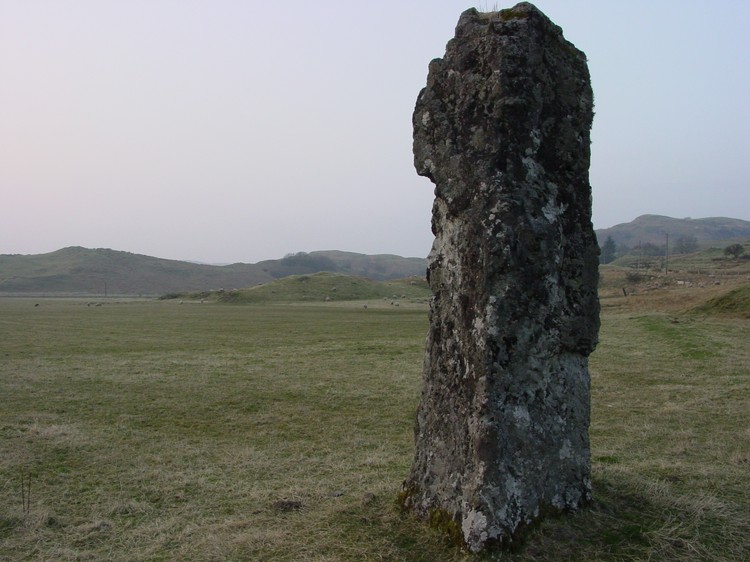
Clach na Carraig submitted by PaulH on 1st May 2003. This is a menhir called Clach na Carraig located just metres from a kerb cairn called Diarmid's Grave. The grid reference is NM908289.
(View photo, vote or add a comment)
Log Text: Clach na Carraign, Lorn: When Andrew said ‘that’s the standing stone’ as we approached it on the road, I thought at first this was just part of an old buttress, like the one’s at St. Matthew’s Old Church in Roslin. I wasn’t until I got closer and had photographed the small cairn to its east, that I really looked saw it was actually a huge block of stone.
It is really impressive, especially so with its location near the stone circle and two cairns. It is right by the road, but we visited the stone circle and the larger, now ruinous cairn, on our way to really appreciate this stone.
Strontoiller Large Cairn
Trip No.87 Entry No.5 Date Added: 29th Jul 2018
Site Type: Cairn
Country: Scotland (Argyll)
Visited: Yes on 17th Jul 2018. My rating: Condition 2 Ambience 3 Access 4
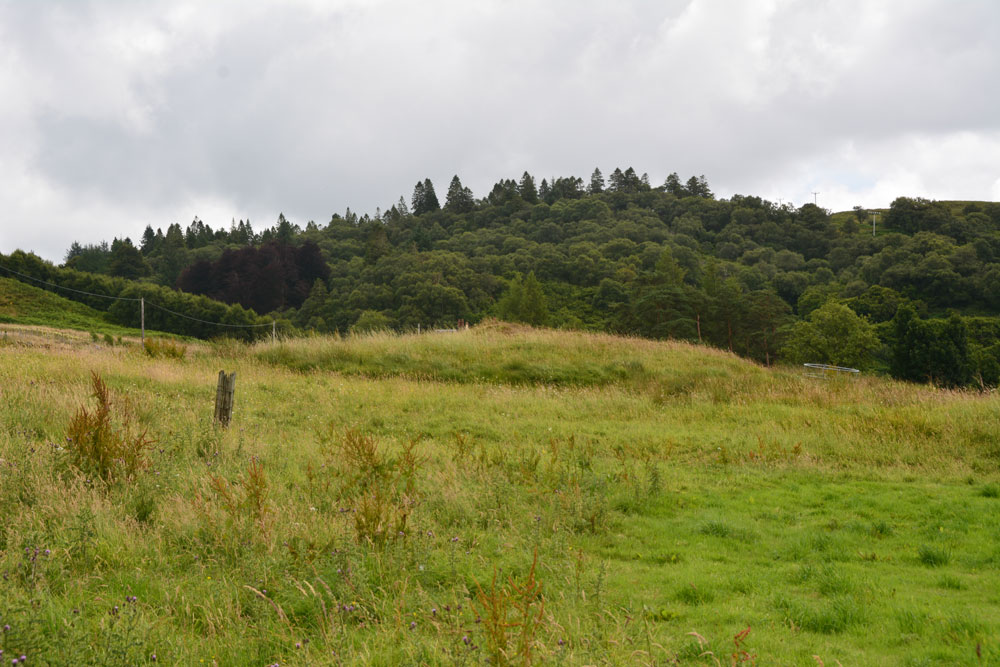
Strontoiller Large Cairn submitted by Anne T on 29th Jul 2018. The larger of the two cairns in this field, as seen from the east of the stone circle.
(View photo, vote or add a comment)
Log Text: Strontoiller Round Cairn, Lorn: This cairn is just to the south west of the stone circle. From the stone circle, it definitely looks like a grassed-over round cairn. As we walked over to it, on our way back to the standing stone, I was not convinced we were looking at the right thing, but the GPS and its position in relation to the stone circle and the standing stone were correct.
In actual fact, looking back on the photographs, and now having seen a number of large, circular, stony cairns, I realise what I was looking at, and wished I’d taken more notice at the time (well, I confess to being keen to see more standing stones before having to head off back to the cottage).
Strontoiller circle
Trip No.87 Entry No.4 Date Added: 29th Jul 2018
Site Type: Stone Circle
Country: Scotland (Argyll)
Visited: Yes on 17th Jul 2018. My rating: Condition 3 Ambience 3 Access 4

Strontoiller circle submitted by Tom_Bullock on 1st Mar 2005. Photo used by kind permission of Tom Bullock. More details of this location are to be found on his Stone Circles and Rows CD-ROM.
(View photo, vote or add a comment)
Log Text: Strontoiller Stone Circle, Lorn: After having taken a few photographs of the small cairn, we walked a couple of hundred yards back along the road to the gate in the field, which is at the corner of the road and the track to Strontoiller farmhouse/cottage. It was a short walk over the pasture to the stone circle – whilst we could see a few stones, mainly the cluster at the northern side (which looked a little like large toadstools popping their heads above the grass), the circle was largely hidden by tall grass and marsh grass.
I was amazed how close the stones were to each other; I’d read about one small stone circle where the stones had been touching, but there were definite gaps between the stones. I thought at first that the stones towards the NNE were part of a ‘double row’, but reading Canmore when I got access to the internet, Canmore says these are four stones which have probably been displaced.
I didn’t get the usual sense of atmosphere at this stone circle, unless others I’d been to, although this was a very pleasant spot, and had three other monuments within a few hundred yards (a small cairn, large cairn and a spectacular standing stone). Worth seeing, and I’d glad we’d stopped. We then strolled the 75m or so to investigate the larger cairn in the field.
Diarmid's Grave
Trip No.87 Entry No.3 Date Added: 28th Jul 2018
Site Type: Cairn
Country: Scotland (Argyll)
Visited: Yes on 17th Jul 2018. My rating: Condition 3 Ambience 4 Access 5
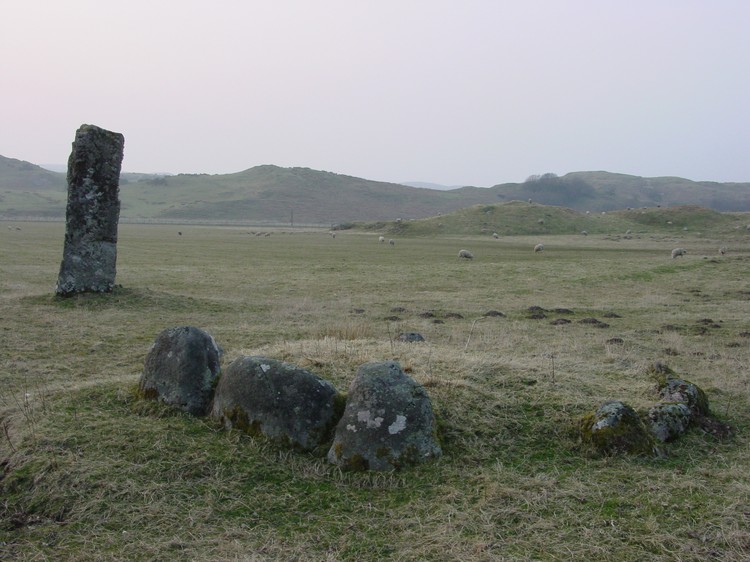
Diarmid's Grave submitted by PaulH on 1st May 2003. A kerb cairn near Strontoiller
Farm to the east of Oban with the standing stone of Clach na Carraig in the background.
(View photo, vote or add a comment)
Log Text: Strontoiller (Small Cairn), next to the Clach Na Carraig standing stone: This was perhaps the most amusing encounter of our whole trip, involving a human and two sheep. As we pulled up by the cattle grid at NM 90788 28935, just before some houses set back from the road, I heard a man’s voice repeatedly shouting loudly: “Go away! Get out of here! Get out!” Thinking he might possibly be shouting at us because of where we’d left the car, I hopped across the cattle grid, only to be almost knocked off my feet by two very large lambs hurtling back across the cattle grid into the field. “Oh, I wasn’t shouting at you”, the man said. “Been naughty?” I asked him, pointing back to the sheep. “It’s always the lambs”, he said, closing the gate.
I asked him if it was OK to park where we where to look at the stone circle, and he replied, “It’s OK. Go ahead. It’s over there.” He pointed, rapidly closing the farm gate into his driveway and scuttled back to his house.
The gate into the field was a little further west along the road, at the junction of the road with the driveway to Stontoiller Farmhouse/Cottage. We let ourselves into the field and walked across to where this neat little stone circle lay, the stones almost buried in tall grass and marsh grass at this time of year. We did a ‘round tour’ of the field, starting off by photographing this neat little cairn, then the stone circle, then the larger cairn, and finally coming back to the standing stone and the small cairn.
Note: the Portal’s page for this site is called ‘Diarmid’s Grave’. I’ve not yet come across any reference with this name in. I’d be curious to know more.
Dalineun
Trip No.87 Entry No.2 Date Added: 28th Jul 2018
Site Type: Chambered Tomb
Country: Scotland (Argyll)
Visited: Yes on 17th Jul 2018. My rating: Condition 3 Ambience 4 Access 4

Dalineun submitted by hamish on 17th Feb 2004. On your way to Strontoiller you must visit this lovely Cairn at Dalnaneun Farm.The chamber and capstone are completely exposed and not much of the original covering is left.It is interesting to see the construction of one of these.Plenty of places to park,but access is over a barbed wire fence which is just at crotch height so be careful.
NM879267.Argyll.Chambred Cairn.
(View photo, vote or add a comment)
Log Text: Dalineun (Dalnaneun Farm) Chambered Cairn, Loch Nell: We made the mistake of thinking the chambered cairn was in the field opposite the crannog, and climbed over a small stile over the fence; however, we realised that we were in the wrong field, climbed back onto the road and walked down to the gate in the field at about NM 88045 26771; this way there were no small streams or field drains to cross.
Climbing up the slope, the stones of the cist came into view – it reminded me of the photos that Kristiansen has been sending in from Denmark. Turning to look east, there were great views across Loch Nell. Another nice place to be buried.
This was by far a much more atmospheric chambered cairn that the one in Adfern that we’d looked at the night before, as the location seemed both isolated and special. We walked round all sides of the cairn, photographing it as best we could. The Barnacarry crannog is visible from here, and I manged to get a photograph with the lens on maximum zoom. Certainly wish I’d had the plan whilst we were here – should have done a lot more research before we visited, but then that takes the spontaneity out of our daily trips.
It was certainly hot up on this hill. I could have stayed here for a few hours, just looking over the loch, but time marched on, and other sites called.
Clach An T-Sagairt (Soroba)
Trip No.86 Entry No.3 Date Added: 28th Jul 2018
Site Type: Chambered Tomb
Country: Scotland (Argyll)
Visited: Yes on 16th Jul 2018. My rating: Condition 3 Ambience 4 Access 4
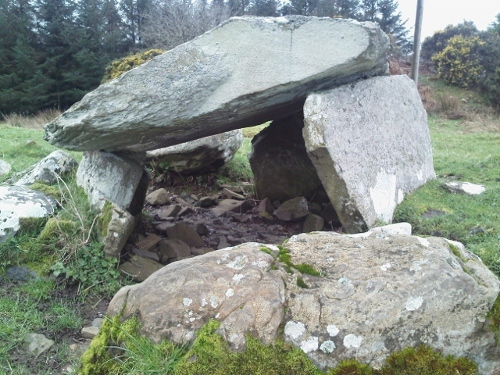
Clach An T-Sagairt (Soroba) submitted by crannog on 16th Mar 2012. Very easy to find. Sits happily and peacefully overlooking Loch Craignish.
(View photo, vote or add a comment)
Log Text: Clach An T' Sagairt Chambered Tomb, Ardfern: From the map, this cairn appeared to be just behind the small school in the middle of Ardfern, and finding a small path behind the back of the school, followed this for about 20m before discovering we were in someone’s garden! The reality was we had to walk up the small road to Ardlarach, going past the school buildings to our right, until we got to what looked like a private road (seemingly unnamed). This led up a slope to the right to a number of other houses. A new gate in the fence to our left hand side led into the field with some beautiful horses, with the cairn some 100 yards straight in front of us.
What beautiful views from this chambered cairn. It looked as if it had a number of ‘arms’ coming out of the central mound, presumably the spoil form the excavations.
We were followed to the gate by a local resident, and we got chatting. She had lived in the village for 16 years and her children, who played on the cairn, told her there were dead bodies and gold in it. She started talking about the whole field being protected if there was an ancient monument in it, so I suggested she looked at Canmore, as it was usually only the area immediately around the monument that was scheduled.
She told us the gate had only appeared in the last few days, and the residents were wondering if a developer was looking to build in-fill houses. Seeing us with a camera walking the site got her worried we'd come to survey the site, so she came out to check.
She also said about once a year, before the gate, people asked to go into the field from her garden.
We went onto dinner at the Galley of Lorne Inn in the village. The last two sites had been a good introduction to this area, and despite the lack of internet and therefore having to rely on the OS map for information, we were both looking forward to seeing the many, many sites around here.
Craignish Sculptured Stones
Trip No.86 Entry No.2 Date Added: 27th Jul 2018
Site Type: Ancient Cross
Country: Scotland (Argyll)
Visited: Yes on 16th Jul 2018. My rating: Condition 3 Ambience 4 Access 4
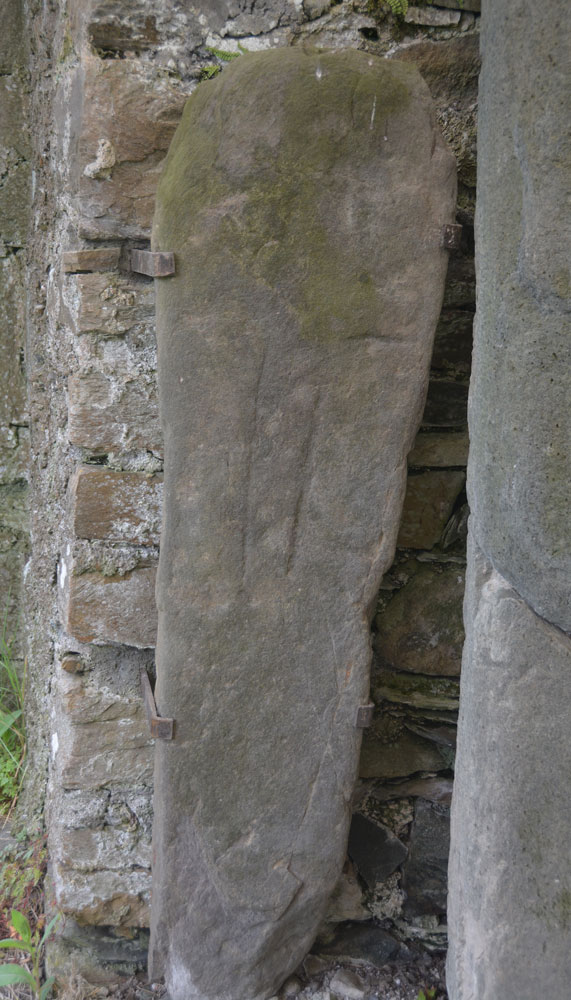
Craignish Sculptured Stones submitted by Anne T on 27th Jul 2018. The one cross slab on display under the shelter inside the chapel. This corresponds to Canmore 318669: slab 1.21m by 0.34m, much worn, which bears the pecked outline of a Latin cross, open at the foot.
(View photo, vote or add a comment)
Log Text: Craignish Sculptured Stones, Kirkton: After having arrived at the cottage we were staying in for the next three nights, we decided to head off to find supper, but taking in a couple of sites on the way, one of which we learned about from Rachel Butter's Kilmartin book, the other marked on the OS map. Not the most auspicious of starts, as a lady on a bicycle rode (at speed) up from the lane leading to the castle and told us off for parking on the grass by the garage near the entrance to the castle. She told us the area opposite had been cleared for a car park. I apologised whilst Andrew moved the car and told her we thought the cleared area was just a large passing place, as the road just in front (heading south) split into two – one road to the castle, the other to Aird Farm. We got chatting and she eventually said ‘not to worry’ (a ‘park here’ notice might have helped). She pointed out the old Kirk and told us to ‘enjoy’, which we most certainly did!
Having moved the car to the layby, we walked up to the metal gates up a short, grassy lane by the side of the modern cemetery, which had a “Craignish Sculptured Stones’ sign hanging on it, and let ourselves into the churchyard. Going through the south door into the church nave, turning to our left (west) there was a collection of old grave markers; to the east are some old box tombs. Almost straight in front of us was a cross base, not recorded on Canmore, with a sundial (see the highlighted entry below).
There are a number of Canmore entries for this location. The ‘Kilmartin’ book by Rachel Butter (page 98) reads: Old Parish Church, Kilmarie, Craignish NM 778 014. This former parish church probably dates to the 13th century though much repair is more recent. It overlooks Loch Craignish and neighbours ruins of a former township, Kirkton. Its dedication was to St. Maelrubha of Applecross. The church contains a collection of medieval slabs which formerly were n the graveyard.
Most of the carved stones are products of the 14-15th century Loch Awe School. They depict crosses, swords, armoured figures in niches, and are mostly carved in local epidiorite or quartzite gneiss. Some are of Easdale slate. There are also some Early Christian slabs (pre 10th century) and some 16th century stone chests.
An epidiorite cross base is carved with a sundial; it has a central socket and 24 rays with cardinal points marked by crosses.
Access: Six miles north of Kilmartin on the A816 take a left turn along the B8002 to Ardfern. You will come to the village after 1 mile. The chapel is a further 3 miles on the left. Kilmarie Church is in private ownership.
Inveraray Castle
Trip No.86 Entry No.1 Date Added: 27th Jul 2018
Site Type: Standing Stone (Menhir)
Country: Scotland (Argyll)
Visited: Yes on 16th Jul 2018. My rating: Condition 3 Ambience 4 Access 5
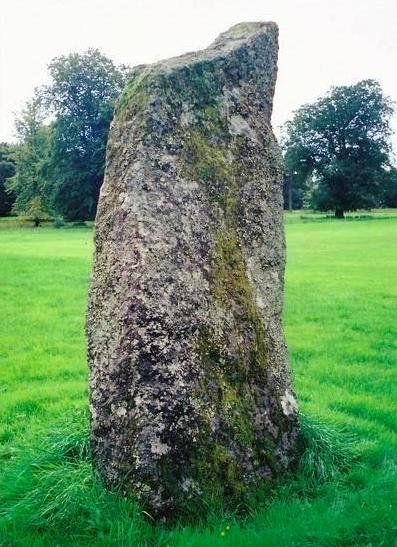
Inveraray Castle submitted by Bladup on 31st Dec 2013. Inveraray Castle standing stone.
(View photo, vote or add a comment)
Log Text: Inveraray Castle Standing Stone: On our way from our daughter’s house to Craignish peninsula (having had the trauma of catching their cat and taking her to the cattery first!) we decided to stop of in Invarary to see our first standing stone of this part of the trip. Mistake.
We arrived the day before the Highland Games at the castle started, so the town was heaving, both with coach tours of largely American tourists, and people attending the games. There was a large funfair on the grass by the harbour, which didn’t aid the flow of traffic through the town.
We managed to turn up the entrance into the castle, only Andrew had to stay in the car whilst I ran out onto the grassy show-ground area to take photographs of the stone. I chuckled to think what the delivery drivers and people putting up the marquees and stands must have thought of this woman running around the stone with a camera must have thought!
St Matthew's Well (Roslin)
Trip No.85 Entry No.4 Date Added: 27th Jul 2018
Site Type: Holy Well or Sacred Spring
Country: Scotland (Midlothian)
Visited: Yes on 15th Jul 2018. My rating: Condition 3 Ambience 3 Access 4
St Matthew's Well (Roslin) submitted by KiwiBetsy on 6th Oct 2006. The water flows into a white (or it probably once was) concrete dome which is brick lined and is very hard to spot in the undergrowth.
(View photo, vote or add a comment)
Log Text: St. Matthew's Well, Roslin: Getting to this well was interesting! Parking in Roslyn Chapel car park at NT 27405 63109, we took the gate from the south east of the car park through the cemetery, then out of the cemetery down a very overgrown lane, with very tall nettles on either side. About 50m from the grid reference for the well, we needed to head off south west into the wood. There were some tracks through here, but obviously not regularly used. We could see a green, mossy mounds/structure through the trees, but couldn’t find a way of getting down to them. In the end, I realised the track had been covered by a heavy, large dead tree branch, which Andrew and I managed to haul away from the path with a little difficulty. Having cleared the track, we used the tree roots as stepping stones at first, then slide the 20m or so down the slope to the well (I told myself it was always easier going up!).
At first we thought there was only one dome here, but looking harder, there was a second one, a few metres up the slope. The front face of the second dome (nearest the river Esk) had a hole in the front, which I poked the camera through to take a photograph. The was a large iron pipe which gushed water into the well chamber. A continuation of this pipe could be seen in a small gully which headed towards the river from the well chambers, although the gloom and all the detitus made it difficult to capture the location.
Heading back to look at the ruins of St. Michael’s church, we looked over the western end of the graveyard, looking south west, and realised we could not only see the well houses, but it also looked as if there were the remains of a wall and steps, as there were cut blocks of stone lying around.
I went back to photograph the 'Spooky Angel' I'd seen when I visited with my friend two years ago (hidden under a bush by the small outbuildings) - she much reminded me of an episode of Dr. Who, where the angels only moved when you didn't look at them.
Glencorse Cup and Ring Marked Stone
Trip No.85 Entry No.3 Date Added: 27th Jul 2018
Site Type: Rock Art
Country: Scotland (Midlothian)
Visited: Yes on 15th Jul 2018. My rating: Condition 3 Ambience 3 Access 5

Glencorse Cup and Ring Marked Stone submitted by uisdean on 19th Apr 2007.
Cup and ring marked stone in Glencorse (NT24706259)
(View photo, vote or add a comment)
Log Text: Glencorse Cup and Ring Marked Stone: Just outside the tall, imposing (and locked) Parish Church, which had an amazing old tree in the field opposite, and a long layby; this village is obviously popular with walkers, as there were lots of cars parked around here, and footpaths leading through the woods, away from the church.
This poor cup and ring stone is contained behind railings, so it looked as if the stone had been caged. The lichen and moss growing on it made it a little difficult to pick out the cups (we certainly couldn’t count 22), and we saw a couple of cup and ring motifs. Even trying to view the stone from different angles, to try and highlight the cups, didn’t make it any easier. A brush and a bottle of water would have come in useful.
I was much amused by the ‘reserved’ signs next to the stone, as if the minister and church warden might have had cars with specially shaped bonnets to fit neatly around the ‘railing cage’.
We did try the church door, just in case, but like many of these churches, locked and bolted. This church had the most amazing number of floodlights around it, so it must have been well lit in the dark.
Castle Knowe (Glencorse)
Trip No.85 Entry No.2 Date Added: 27th Jul 2018
Site Type: Ancient Village or Settlement
Country: Scotland (Midlothian)
Visited: Yes on 15th Jul 2018. My rating: Condition 2 Ambience 3 Access 4
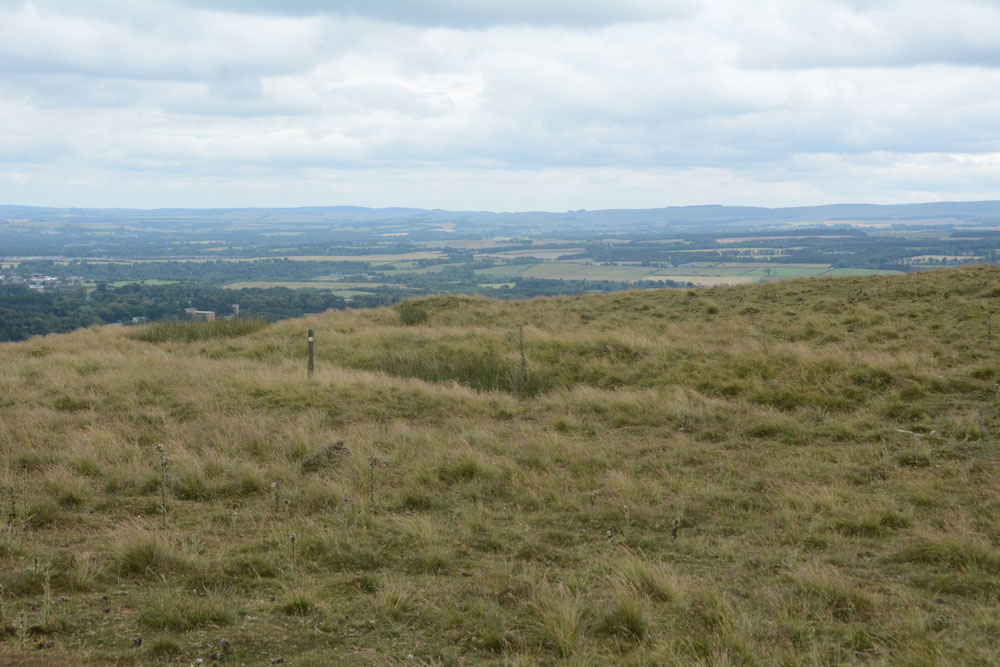
Castle Knowe (Glencorse) submitted by Anne T on 27th Jul 2018. The main line of the low palisade bank/trench to the north eastern side of this palisaded settlement.
(View photo, vote or add a comment)
Log Text: Castle Knowe Palisaded Settlement, Glencorse: From Castle Law hill fort, we continued northwards up the track, turning right up another footpath onto the Castle Knowe Palisaded Settlement. I stopped half way up to get some photos of Castle Law Hill Fort, looking down on it. There were a few other people walking up the track, and whilst they had largely stopped at the fort to look quickly around, no-one paid any attention to this settlement.
There wasn’t a lot to see, apart from some small boundary banks and ditches on the northern and just the north eastern side. There is a modern cairn on top – just a pile of red sandstone rocks, but this was very eye-catching, particularly from the car park and fort below, mostly because of its red colour.
The military earthworks to the north of this settlement look like a much more substantial monument, but are just for military training exercises.
Whilst there were only a couple of the palisade trenches visible on the north and north east side of the settlement, and possibly signs of one of the timber house circles, it was well worth walking further up the hills for the views to the east and north.
Castle Law
Trip No.85 Entry No.1 Date Added: 26th Jul 2018
Site Type: Hillfort
Country: Scotland (Midlothian)
Visited: Yes on 15th Jul 2018. My rating: Condition 3 Ambience 4 Access 4
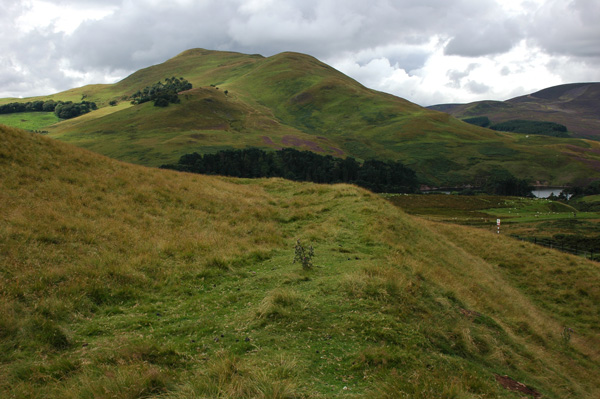
Castle Law submitted by nicoladidsbury on 14th Oct 2007. Castlelaw Hillfort - this photo shows the earth banks and terraces of the hill fort.
(View photo, vote or add a comment)
Log Text: Castle Law Hillfort, Glencorse: First stop of the day, and I was surprised this hill fort was so close to a modern military firing range. Because of its proximity to Edinburgh, there were a few other people parked in the small car park below the fort, but very few walked up onto it; a track carried on up the hill.
The earth house was very unusual, with steps leading down into it, and a narrow, curving passage leading into it. About half way down, a small doorway leads into a circular chamber.
We searched, and found, the cup marked stone towards the eastern wall of the terminus. If other stones had been put on top of this, the cups couldn’t have been seen. It was difficult to capture the cups (and some micro-cups?) in the dim lighting, even using flash and a torch, and had me giggling with our efforts to get a good photograph.
We walked round the inner defences of the fort, admiring the shooting range below, then carried on up the hill to what was left of the palisaded settlement. Walking up the hill to this site gave us an excellent view down on to the hillfort.
Market Cross (Kincardine)
Trip No.84 Entry No.10 Date Added: 26th Jul 2018
Site Type: Ancient Cross
Country: Scotland (Fife)
Visited: Yes on 14th Jul 2018. My rating: Condition 3 Ambience 2 Access 5

Market Cross (Kincardine) submitted by Anne T on 26th Jul 2018. Apart from the finial, this Mercat Cross in Kincardine was virtually identical in style to the Mercat Cross in Clackmannan, not that far away.
(View photo, vote or add a comment)
Log Text: Mercat Cross, Kincardine: Our last stop of this very hot day, thankfully. This cross was in a very busy stop, next to the main bus stop in the town, with lots of take away shops around the ‘triangle’ of what might have been the village green. Not an impressive site, although the cross (apart from the finial) seems almost identical to the Mercat Cross, Clackmannan. Just one to 'tick off the list' that we've seen it (and photographed it).
